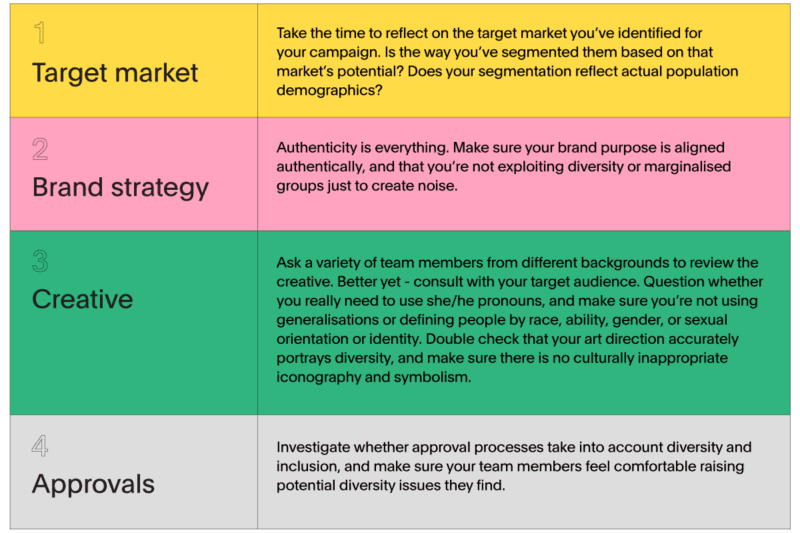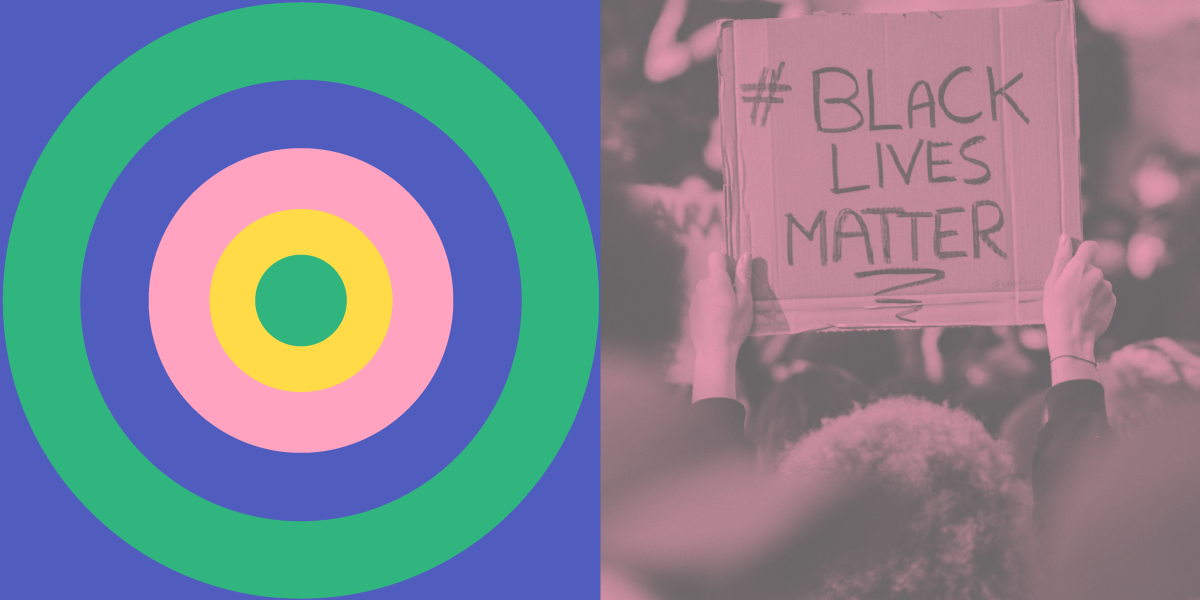Eloise Richards, Senior Communications Consultant, Fellowship recipient, 2020
As marketers, communicators and creatives, we have immense power over the messages and images consumed by millions of people online, and in the media, on a daily basis. Whether it’s the copy we write, the videos we produce or the ads we place, we’re able to elevate the stories and voices of people who are marginalised or underrepresented within our communities, to influence positive social change.
But how can we achieve this in a way that moves beyond simply ‘ticking the diversity box’ for a campaign?
Despite our good intentions, it takes more than just simply featuring a range of people from different cultural backgrounds or someone with a visible disability in your ads. These days, consumers will sniff out tokenism from a mile away — which can not only lead to reputational damage, but send us backwards in building a more peaceful, and cohesive society.
To give both our team at Fuller, and the broader industry, the skills and confidence to apply a diversity and inclusion lens to the work we do in an authentic and meaningful way, I developed a practical guide for how marketing and communications can be used as a tool for social change, as part of the Fuller Fellowship initiative.
The Fuller Fellowship was established in 2020 by Fuller’s Managing Director and founder, Peter Fuller, and is a 12-month program for a staff member to undertake a travel and research study in an area of professional interest.
My Fuller Fellowship journey has involved undertaking research, some revealing interviews with individuals from a diverse range of backgrounds, and a personal journey of reflection as I’ve delved into the exciting, yet sometimes misunderstood topic of inclusive marketing.
Beyond box-ticking
In 2021, inclusive marketing should be more than just featuring people from different backgrounds in your ad campaign.
Inclusive marketing encompasses the messaging, people, processes and technologies that enable marginalised or underrepresented groups to fully experience and connect with your brand. It strives to create a visual culture that is representative of things like skin tone, gender identity, age, sexual orientation, ethnicity, culture, language and/or physical and mental ability.
It requires you to understand — and authentically represent — the various identities, histories, differences and similarities that co-exist between people in Australian society today.
After all, Australia is a vibrant, multicultural country — home to the world’s oldest continuous cultures, and Australians who identify with more than 270 ancestries!
This is something Telstra demonstrated in their latest brand campaign, ‘Australia Is Why’, which launched this July.
Highlighting Telstra’s work in sustainability, sponsorship, connectivity and community, the campaign showcases its role in the Australian community.
According to Telstra’s Chief Marketing Officer, Jeremy Nicholas, the campaign was designed to be “quite emotive” and tell the country’s story, using real people — not actors.
“They’re all real customers, or they’re real people, rather than actors,” he said.
“They are the people who are our customers … We were just aiming to reflect that … We wanted to make them feel warm and true and honest and reflect the diversity of our base and diversity of this country.”
Telstra has been leading the way in casting people from different backgrounds in its marketing campaigns for several years now, reflecting both the diverse nature of Australia, and the company’s workforce.
“We…try to reflect who we are,” he said.
“Telstra itself is a very diverse employer as well, and it reflects our people as well, and who we are, and it’s a very inclusive place to work in.
The focus on diversity in the teams is really key.”
Everyone in your target audience wants to see themselves in your marketing, and they want to know that you ‘see’ them too.
This is something our favourite fruit-salad loving, big red car-driving children’s band also recognised, and recently addressed — expanding their line up to eight Wiggles, as part of its new YouTube series Fruit Salad TV.
The four new cast members come from a range of backgrounds, including Ethiopian-Australian, Chinese-Australian, and Indigenous Australian, and were selected to “inspire a diverse audience with its gender-balanced and diverse cast” and make sure children around the world “see themselves reflected on the screen”.
The benefit is real
The benefits of inclusive marketing extend far beyond a recognition of all Australians living in our community.
With 62 per cent of us believing that diversity in advertising is important, when an organisation actively meets the needs of their diverse customers, the economic pay-off is high, too.
“These organisations are rewarded with stalwart supporters who return for repeat business, and actively campaign within their communities on behalf of that organisation,” states the ‘Missing out: The business case for customer diversity’ report produced by Deloitte and the Australian Human Rights Commission.
Google, partnering with Ipsos and the Female Quotient undertook similar research in the US, surveying 2,987 consumers of various backgrounds to better understand perceptions surrounding diverse or inclusive ads.
They found that people were more likely to consider, or even purchase, a product after seeing an ad they believed was diverse or inclusive.
In fact, 64 per cent of those surveyed said they took some sort of action after seeing an ad that they considered to be diverse or inclusive, and this percentage was even higher for LGBTIQ+ (85 per cent), millennial (77 per cent), and teenage (76 per cent) consumers.
But the benefits of inclusive marketing aren’t just fiscal.
Brands are also likely to see their approval and perception ratings increase amongst consumers when they undertake inclusive advertising.
Check yourself!
Before you can start developing inclusive marketing campaigns and content for your brand, the first — and most important step — is to recognise and address your own bias.
Anything and everything can be subject to unconscious bias — ethnicity, race, age, gender, gender identity, physical/mental ability, religion, sexual orientation, body weight and image — even who we chose to date, where we chose to live or the friends we chose to keep.
“Even though we like to think we always apply logic and reason in our decision-making, implicit or unconscious attitudes or stereotypes (based on our life experiences and backgrounds) affect our understanding, actions, and decisions,” writes Katie Spearritt for AdNews.
Unconscious bias can have negative consequences for those subjected to that bias (for example, people with a disability, the LGBTIQ+ community or migrants), further perpetuating negative stereotypes that might exist.
These consequences could include unfair treatment and poorer health, education, and employment outcomes, as well as facing discrimination.
“I want to see an accurate reflection of Aboriginal people and our culture, not just that we have higher rates of diseases and that we can’t look after our own children, land and communities,” said Aboriginal woman, Nicole Clinch, who shared her thoughts in the guide.
“Sometimes it’s easy to see why some people are so uneducated when that’s all they hear about us.”
But it’s not just First Nations people who are subject to bias, and stereotypes. When talking of representation of older Australians in the media and marketing, David Militz, CEO of Carers SA, said: “Everyone will get old and it should not be frightening. It should be embraced, and what comes with ageing — things like experience and wisdom — should be celebrated.
“Unfortunately, this is outweighed by fear of illness and death and the stereotype of losing individual value.”
Get educated
The only way to address bias in order to develop authentic inclusive and diverse marketing campaigns is to pay attention to the society and culture that you live in — and educate yourself.
In the production of the guide, I looked at the representation (in many cases, under, or misrepresentation) of five marginalised groups within Australian society: First Nations Australians, people with disability, LGBTIQ+, culturally and linguistically diverse (CALD) Australians and older Australians.
This involved collating statistics on each of these groups, their views on how they feel they are currently being represented, appropriate and respectful language, creative considerations, and visual representation.
This process has seen me question my own biases, privilege, and position in society, and learn a whole lot in the process. And while this journey of discovery is by no means complete, I hope the guide — or even just reading this blog — acts as a catalyst for you to do the same.
The guide at a glance: 10 tips for inclusive marketing
1. Be curious and open to learning
Build your understanding of issues facing underrepresented, or minority communities from people who are members of these communities themselves. Ask questions, be vulnerable, arm yourself with facts and be prepared to question stereotypes.
2. Authenticity is everything
Think twice before you plaster your brand with a rainbow flag for Mardi Gras, or state your support for a social movement like Black Lives Matter. If you exploit diversity to simply create, or add to the ‘noise’ around a particular issue or social movement, you risk having your intentions and commitment critiqued by your consumers. Afterall — actions speak louder than words, so make sure your organisation is actually investing resources in the cause and is genuinely supported by your staff and management.
3. Recognise your own unconscious bias
We all hold biases. Often, they’re so ingrained we hardly notice them! But as marketers, unconscious bias is what we need to watch out for most when we’re undertaking inclusive marketing campaigns. You could consider taking the Harvard Implicit Association Test (IAT) – an online tool to help you learn more about your own biases, preferences and beliefs.

4. “Nothing about us without us”
A theme that was consistent across all five groups I spoke with was the importance of consultation when you’re developing a campaign targeted at, or being inclusive of a particular minority group. Not only will it help you ensure you’re accurately portraying their community, but you might also pick up some great ideas along the way too. “We have a lot to offer and could potentially give a fresh and exciting perspective on some projects,” said Ngarrindjeri man Adam Rigney. “Maybe some subtle and tasteful nods to the local culture would go a long way in the eyes of our
communities.”
5. Avoid generalisations
Don’t make generalisations or define people by their race, ability or gender, or perpetuate stereotypes. Little things, like questioning whether you really need to use she/he pronouns, can go a long way to making your campaign more inclusive.
6. Seek feedback
A few years ago, the Yellow Pages in Canada launched an advertising campaign promoting their new app with the copy: “Find out if Bi Bim Bap tastes as fun as it sounds.” The ad included an illustration of a bowl of noodles…but bibimbap is actually a Korean dish made with rice (that literally translates to ‘mixed rice’!) The Yellow Pages learned the hard way that it’s always a good idea to ask people from different backgrounds to review your campaign — from messaging to creative — to avoid conveying any unintentionally offensive or inappropriate messages, or in this case, cultural gaffes. It’s important that whoever undertakes the review feels comfortable raising any potential diversity or inclusion issues they find.
7. Inclusive marketing starts from the inside out
The most successful inclusive marketing campaigns are the ones that are created by diverse teams — people with different backgrounds and life experiences. Think about whether your workplace could be doing more internally, through recruitment and staff education initiatives, to champion diversity and inclusivity.
8. Use inclusive and respectful language
When used correctly, language can create a sense of empowerment, pride, identity and purpose, but when used incorrectly, it can be discriminatory, offensive and degrading, and reinforce harmful stereotypes. A number of guides have been published to help the public, as well as those working in marketing and media, understand how to use language respectfully and inclusively which are worth reviewing. But if you’re ever in doubt — you should always ask how a person prefers to be described, or introduced.
9. Recognise diversity within communities
When you’re developing a campaign targeted at, or being inclusive of a particular underrepresented community, it’s important to remember that they’re not one audience or market with the same background, interests, and experiences. For example, for the first time in history, demographers have identified three separate generations within ‘the over 50s’ audience, and these generations should be kept in mind when engaging and developing campaigns with older Australians.
10. Pledge your case
If you’re committed to developing more diverse and inclusive marketing campaigns but still need to get it over the line with management, arm yourself with all the facts and figures that prove just how beneficial being inclusive really is — not just for society, but your company’s bottom line too.
Eloise Richards
2020 Fuller Fellow
Download the full guide


